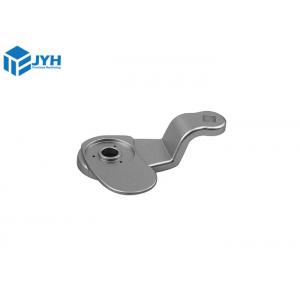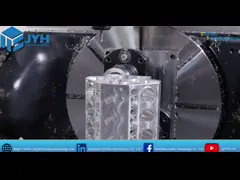Custom Die Casting Service For Zinc And Aluminum Of Shape Intricate
Conponents
WHAT IS DIE CASTING?
At JYH-precision machining,die casting is a remarkable metal
fabrication process that harnesses the power of high-pressure
molten metal to shape intricate parts. The materials of choice are typically non-ferrous metals such as
zinc, copper, aluminum, magnesium, and various alloys.
Advantages of Die Casting Process
Die casting stands as a significant technique in metal fabrication,
esteemed for its cost-effectiveness and user-friendly nature.
The advantages it brings:
- Accomplish intricate part designs
- Reduce labor expenditures
- Attain varying wall thicknesses
- Achieve stricter tolerances
Disadvantages of Die Casting Process
- Incompatible with metals boasting elevated melting points
- Incompatible with extensive sheet metal components
- Substantial die expenses
- Extended lead times
Die Casting Alloys
Die casting commonly employs non-ferrous alloys prized for their
robust mechanical attributes. These non-ferrous components
contribute to the alloys' low melting points, which align with
their strong mechanical performance.Below, we list a few popular
alloy options:
Aluminum Alloys
|
| Aluminum alloys possess versatile qualities for various product
uses, with 380.0 being a popular die casting preference. Other
options like Alloys 360, 390, and 413 also exist, chosen based on
factors such as specific application requirements.
- Elevated operational temperatures
- Remarkable resistance to corrosion
- Lightweight nature
- Notable strength and hardness
- Favorable combination of stiffness and strength-to-weight ratio
|
Zinc Alloys
|
|
Zinc alloys offer remarkable strength, resilience, stability,
efficiency, and cost-effectiveness.
A variety of zinc alloys are available for utilization.
Nevertheless, the prevalent zinc materials for die casting include
Zamak #2, #3, #5, #7, ZA8, and ZA27, celebrated for the ensuing
qualities:
- Enhanced Castability
- Reduced Cycle Duration
- Prolonged Die Lifespan
|
Other Alloys
|
Die casting parts can also be crafted from alternative alloys such
as Bronze, Brass, lead, and tin.
Bronze, specifically white bronze, finds favor in the jewelry
sector for die casting. It boasts a color akin to white gold and
stainless steel alloys while remaining an ideal choice due to its
lower melting point.
|
FAQ:
- Mold and Sample Lead Time
|
For standard projects, we ensure the completion of mold creation
and delivery of the initial sample within a time frame of 25 to 30
days. For expedited projects, our commitment is to accomplish mold
creation and provide the sample within a maximum of 15 days.
|
|
For mold/tooling and samples: 50% deposit on order, remaining 50%
post sample approval. For new customer production orders: 30% advance payment, balance
70%. Long-term valued customers enjoy even better terms: 100%
payment on delivery.Can be negotiation.
|
- How to Address Non-Conformity or Other Disputes When Raised
|
Quality is our priority in every step, from production to QC. While
we maintain high standards, in rare cases of non-qualified
shipments, we'll collaborate to minimize losses, learn, and ensure
future excellence. If issues arise, we'll work with our clients for
solutions including compensation or replacements.
|
Types Of Die Casting Processes
In the industrial realm, two main methods for die casting are the
hot chamber and cold chamber processes.
Below, we outline the details of these two processes.
Hot-chamber die casting
|
|
Hot-chamber die casting utilizes a molten metal reservoir to fill
intricate molds quickly, making it ideal for low-melting point
alloys like zinc and tin.
|
Cold Chamber Die Casting
|
|
Cold chamber die casting is excellent for handling high melting
point materials like aluminum, preventing damage to the pumping
system caused by extreme temperatures. In this method, molten
material is poured into a cold chamber before being injected into
the die, utilizing a hydraulic system similar to hot chamber
casting.
|
Surface Finish
Surface finishing is crucial in die casting to enhance product
aesthetics and functionality, ensuring parts meet precise
specifications and provide optimal performance.
| |
Powder Coating
| Ceramic Coating
|
| |
Anodizing
| Plating
|
Die Casting Process
Whether it's hot or cold chamber die casting, the standard
procedure involves injecting molten metal into a die mold using
high pressure.
Here are the detailed steps in the die casting process:
| l Clamping At the outset, clean the die to eliminate impurities and apply
lubrication for smoother injection and product removal. Once
cleaned and lubricated, firmly close the die with high pressure. |
l Injection Melt the chosen metal and pour it into the shot chamber. The method
differs based on the process being used. |
l Cooling While the die is closed, allow the metal to cool and solidify. The
resulting solid material will take on the shape of the mold design. |
l Ejection After unclamping the die mold, an ejection mechanism will push the
solid casting out of the mold. Make sure the product has fully
solidified before ejecting. |
l Trimming This marks the final step, involving the removal of excess metal
from the sprue and runner on the finished product. Trimming can be
done using a trim die, saw |
QUALITY CONTROL
At JYH-Precision, excellence is infused into every facet of our
operations.
Pacific Die Casting, along with its dedicated workforce, is
steadfast in its dedication to fulfilling both customer and legal
prerequisites, with the aim of attaining utmost customer
contentment. Our unwavering goal is to consistently deliver
high-quality products punctually, while consistently enhancing our
Quality Management System.
Shipping way:
Payment method:
After service:
Custom High Tolerance Die Casting Service For The Metal To Shape
Intricate Conponents. We are your best partner!



